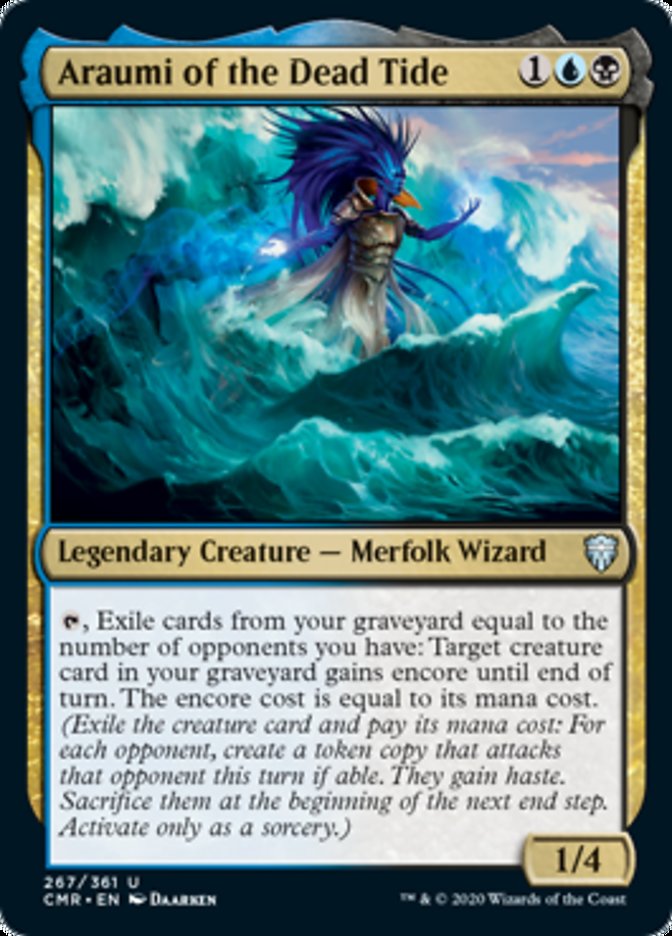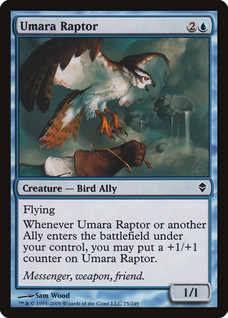The Dead Tide
- PDH Home Base

- Nov 14, 2020
- 7 min read
Hello PDH Homebase readers! Dave (Alkadron) here. I’ve been on the PDH Homebase writing team as an editor for a while now, but have never written a piece of my own… until now. What’s changed?

Araumi of the Dead Tide is what’s changed. And she changes everything.
Lets talk for a moment about how cool the Encore cards are. (Assume for the rest of this article that you have three opponents. The math goes very differently with more or fewer, but we need a standard baseline to work from, and three is a good number.) I think Wizards did an outstanding job attaching abilities to the Encore creatures to keep them interesting. Briarblade Adept has an attack trigger that shrinks creatures. Getting three of those at once kills significant creatures, that’s great! Trove Tracker has a death trigger that draws a card. Drawing three cards off a card in a graveyard is incredible! Kinsbaile Courier has an Enters the Battlefield (EtB) trigger that puts counters on creatures. Getting three of those triggers at once is a real good deal!
The point is: Encore is very fun. Getting to triple the effects of a creature entering, attacking, and dying is incredibly cool design space to play with. Typically we play in this space that Wizards has designed: they choose which cards get Encore so we don’t go nuts and start breaking things… except not this time. Gentlemen, ladies, everyone in between -- it’s time to go nuts and start breaking things:
Getting to decide for ourselves which (blue and black) creatures should have Encore is a fantastically cool space for us to play in! We can pick our favorite EtBs, like Burglar Rats or Aethersnipe, and just triple those effects! We can pick our favorite dies-triggers, like Nocturnal Feeder or Mortis Dogs, and triple those effects! We can even triple activated abilities, like Merfolk Looter or Hapless Researcher!
For a lot of these cards, like Burglar Rats or Merfolk Looter, we don’t even have to worry about getting them in our graveyard. Just casting them and using them as regular creatures until they die is a good plan all on it’s own. Having the option to get their effects three more times later in the game is just a huge advantage for us.
But listen - I can tell you’re not impressed with multiplying things by three. Or even four or five, if you have an unusually high number of opponents. You think we can do better, and I agree. What’s better than multiplying an effect by three? Lets see if we can multiply it by nine.
Magic has a handful of mutual-buff-tribal-mechanics that compound upon themselves. Slivers are probably the most famous of these--each sliver provides a static bonus to all slivers. If you have three slivers, they each have all three abilities. However, static bonuses are not what we’re after with Araumi.
(pictured above: not what we want to do)
Allies from the first Zendikar block are a bit like Slivers, but for triggered abilities: they all trigger themselves and each other whenever an ally enters the battlefield. The zuberas from Champions of Kamigawa are also similar; their death triggers get stronger for each zubera that died that turn.
The first beautiful thing about Encore is that it creates all three token copies at the same time. That means if you Encore something like Kalastria Healer, each of the three copies sees each other copy entering the battlefield. So each token copy of the Healer triggers three times, for a total of nine triggers: each opponent loses 9 life and you gain 9.
The second beautiful thing about Encore is that, assuming none of your token copies die in combat, they all get sacrificed at the same time when your turn ends. (For cards like the Zuberas, where it’s important that they die together, you can Encore them in your second main phase to effectively skip Encore’s “must attack if able” clause.) Just like three Kalastria Healer tokens all see each other entering the battlefield, all three Zubera tokens will all see each other die, and each trigger will be for three cards. Encore-ing a Floating-Dream Zubera lets you draw nine. Encore-ing an Ashen-Skin Zubera forces your opponents to discard nine (total, not each).
This basic idea of utilizing cards that trigger not only off themselves, but once for each copy, is how we get from three to nine, and this is where the big effects start piling up:
- Three Vengeful Dead dying together will cause each opponent to lose nine life.
- Three Falkenrath Nobles dying together will cause one opponent to lose nine life while also gaining you nine life.
- Three Grim Guardians entering the battlefield together will cause each opponent to lose nine life.
- Tapping three Shepherd of Rot will cause the whole table to lose nine life.
This is the math we want to be doing with Araumi.
Now, I know what you’re thinking. I see that look in your eye. You’re not impressed with nines. It’s so close to double digits, but it’s not quite there. Double-digits would be better. I hear you, reader, and I have good news: I can deliver double-digits easily.
If you encore Gary (as I affectionately refer to the Gray Merchant of Asphodel), even with nothing else in play but Araumi, you get seven devotion to black and three Garys. Each opponent will lose 21 life while you gain 63. But Gary’s easy, that’s the effortless way to break into double-digits. You’re here because you want the exciting stuff; I get it. I got exciting stuff.
Consider, dear reader, cards like Norritt and Tidewater Minion: How does our math change if we can untap Araumi? A lot depends on what cards are available, so let’s talk examples:
- If you Encore a Shepherd of Rot and a Vengeful dead together, each Shepherd activation causes 6 points of life loss to each player. At the end of turn, three Shepherds die, then three Vengeful Deads die, and each of these six deaths triggers all three Vengeful Deads. Altogether, each opponent loses 36 life.
- If you Encore a Grim Guardian, and then any other enchantment creature, the Guardians see themselves enter (for a nine points of damage on each opponent), and then each Guardian sees three additional enchantments entering, for an additional nine points of damage on each opponent. Each opponent will lose a total of 18 life.
- Kalastria Healer followed by another Ally uses the same math as Grim Guardian followed by another enchantment.
- If you Encore a Falkenrath Noble and literally any other creature, each of the three Nobles sees six creatures die, and you drain an opponent for 18 life while you gain 18.
- Encore-ing something with a single black mana symbol in it’s cost, then Gary, means that your devotion is at least 10. Something with two black pips and then Gary puts your devotion at at least 13. You wanted double-digits? Double-digits is for amateurs, I give you triple-digit life-gain: three Garys with 13 devotion is 117 life.
So the math here with a single untap is clearly out-of-control. Can we untap Araumi several times, to do even more degenerate shenanigans? Absolutely we can! I’ll leave the mathematics of those degenerate shenanigans to you, since the particulars will vary widely from case to case. (If you think of a good example, or you execute an impressive combination, let me know!)
Instead of getting into that math, and the increasingly convoluted hypotheticals that go with it, I want to talk about untapping Araumi, and the various ways we can accomplish that, and the costs involved.
(Pictured above: not what we want)
First, let’s notice that the untappers I mentioned earlier (Norritt and Tidewater Minion) weren’t Refocus or Twiddle. Why? Because Refocus and Twiddle aren’t creatures. Non-creatures do nothing for us from our graveyard. On the other hand, Norrit and Tidewater are cards that we can Encore. That will let us untap Araumi three times for up to four total Encore-ings in one turn. But that costs a lot of mana. How can we do that more efficiently?
Teardrop Kami can be cast from hand for a single mana to untap Araumi once. Then it can be Encored for just one additional mana to untap Araumi three more times. In terms of Encore-untapping-effeciency, Teardrop is king.
Corridor Monitor functions similarly, but is a bit more difficult to work with since it’s an EtB trigger instead of a sacrifice activation. If we Encore it, all the EtB triggers happen at once. We can stack all three untap effects on Araumi and tap her as each resolves, even though we have to wait until later to actually start Encore-ing the cards we targeted with her (i.e., activating Araumi is instant-speed, Encore-ing a creature is sorcery-speed). Utilizing this stack-of-untaps from Corridor Monitor or Pestermite is plausible, but it’s very expensive in terms of graveyard resources, since each activation of Araumi requires us to exile three cards from the graveyard and we have to do them all at once.
These considerations bring us to what is arguably the most important part of an Araumi deck: self-mill (filling your own graveyard with cards from your library). The good news is that there’s a lot of really great creatures that do this for us. (Again, like Twiddle and Refocus, there are non-creature spells we could use for this. But we shouldn’t, since non-creature spells don’t Encore.)
Laboratory Brute, Crow of Dark Tidings, and Gorging Vulture are examples of cards that we can cast early from our hand to fill up our graveyard bit by bit. Once one of them dies (or if we mill one), we can Encore it to mill a lot more all at once. This not only gives us the fuel we need to burn to activate Araumi’s ability, it also gives us huge card selection, since we’re mostly Encore-ing cards from our graveyard instead of casting from our hand. Fortunately for us, life drain isn’t the only effect with cards that see each other EtB for compounding results:
- The Crabs see each other but sadly not themselves, so three entering at once mills a total of 12 cards. If you can follow that up with a snow land, you get six more. Afterwards, watching the 0/4s be forced to attack is cute.
- Thassa’s Devourers see each other and themselves, for a total of 18 cards dumped into your graveyard. They also trigger Grim Guardian if you happen to have three of those in play.
- Halimar Excavator is the undisputed champion of the deck. Each copy triggers three times to mill for three, for a grand total of 27 cards. Considering that each of those cards becomes available to you as both a potential threat that you can Encore and as the primary resource you spend to Encore things, 27 is a colossal number.
There’s so much more to say about an Araumi deck (e.g., ramp, protection, control, discarding ... ) but I want to leave some things for you to imagine and discover for yourselves. If you brew a deck for Araumi: I hope you found this article to be inspirational and encouraging, but more than that, I hope that you get in touch with me about it! I’d love to see what you come up with.
Thanks for reading!
- Dave








































































Comments